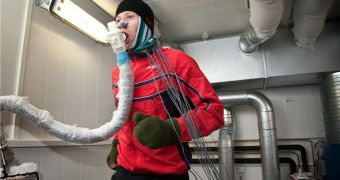Scientists at SINTEF, the largest independent research institute in Scandinavia, are currently conducting a scientific experiment to determine the physiological limits of our endurance to cold. This line of study is actually very important, as it promises to provide experts with sufficient amounts of new knowledge to allow for the development of new technologies to protect people working in harsh, cold conditions. This includes researchers working in Siberia, Antarctica and the Arctic, where temperatures tend to be rather low. Poor insulation against the weather often leads to frostbites, or in the most extreme cases to death, AlphaGalileo reports.
“The results so far show that cold has major effects on both fine and coarse motor capacity, which indicates that there is a real need for new clothing concepts,” explains SINTEF team member Oystein Wiggen. “It is impossible to imagine what it is like to work in the harshest climate areas, where temperatures can fall to minus 60 degrees. What is clear is that there is a need for advanced protective clothing when you are working under these conditions. And work of this sort is necessary, because technical equipment needs constant maintenance in extreme cold. This is why the tests that we are carrying out just now are an important aspect of the ColdWear project,” explains research scientist and project manager Hilde Faerevik.
Over the past six months, a host of experiments have been conducted on 21 test participants, who were asked to endure six types of temperature conditions. These ranged from +20 to -25 degrees Celsius, and during their stay in special chambers, the volunteers performed various tests. One of the most important is the “manual capacity” assessment, which determines how temperature influences our ability to move our hands, or to perform fine actions. The conditions required for this to happen were also determined during these trials. The ultimate goal of this investigation is the creation of “intelligent,” extreme-weather clothing that could protect its wearers depending on outside temperatures.
“We are thinking of clothes made of functional materials which, for example, can store excess body heat that can be extracted from the garments when the temperature falls again. We are also developing clothing with integrated sensors that both monitor the person wearing them and communicate with the outside world,” Faerevik says. Another thing that the research team plans to do is conduct interviews with people who have endured such extreme conditions. Their input could prove valuable for the study, in very much the same way athletes' advice is taken into account when a company builds new, high-performance running shoes.

 14 DAY TRIAL //
14 DAY TRIAL //